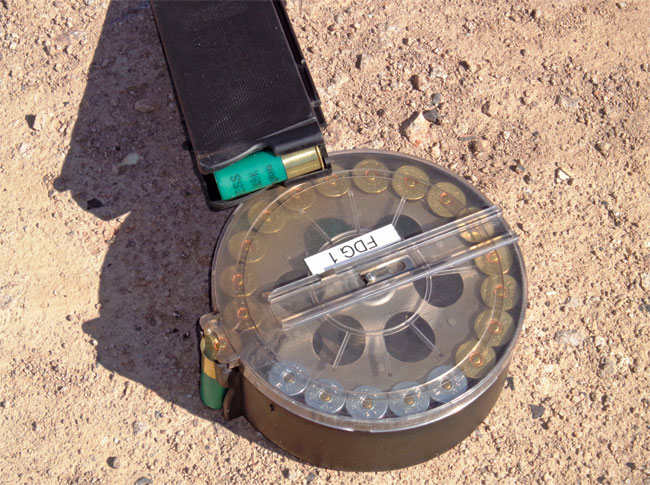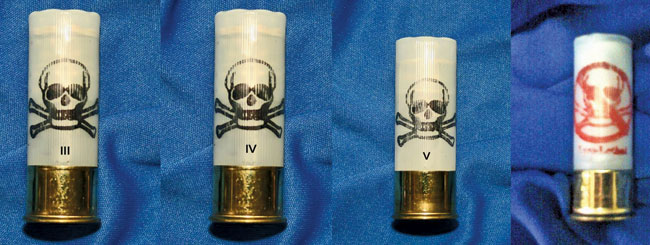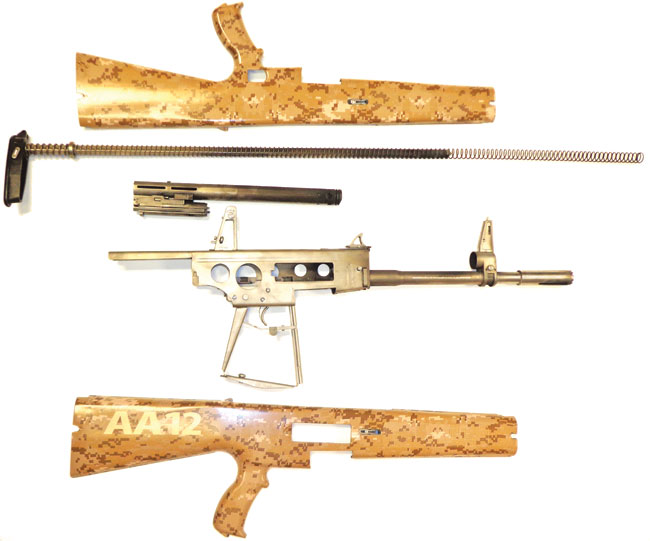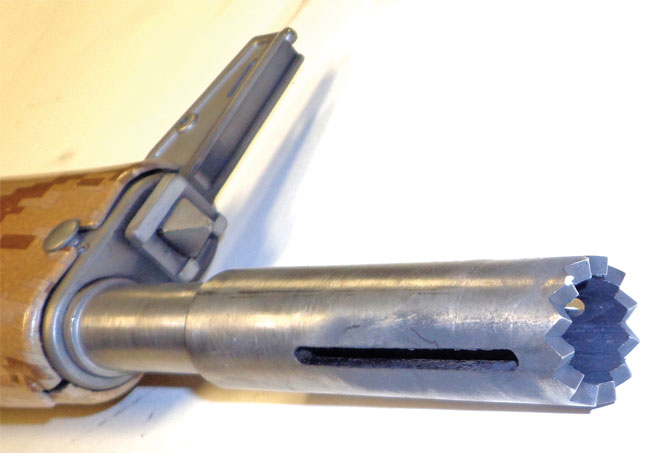ABOVE: The author firing the AA12 in the desert outside of Las Vegas. Recoil was surprisingly light and this had a lot to do with weight and the low 300 rounds per minute cyclic rate.
One does not often think of shotguns as viable combat weapons and in the law enforcement arena, shotguns have lost traction in favor of the patrol carbine. The destructive power of the 12 gauge shotgun is not disputed; the real issues with the changeover had more to do with the patrol carbine being more versatile with its ability to penetrate body armor and reduce collateral damage from stray pellets. In the military arena, the shotgun still has its place but it’s rather limited. The standard issue shotguns, the Mossberg M590A1 and the M1014 (Benelli M4 semi-auto) see service in all branches. Back in 2004, the Marines were testing another shotgun, one that is completely different from the rest, a true machine gun, the AA12 aka the Atchisson Assault 12 gauge shotgun.
In 1972, Maxwell Atchisson developed a shotgun unlike any other. This is a fully automatic, blowback operated shotgun that fired from an open bolt position. It fired from either an 8-round box magazine, or a 20- or 32-round drum magazine. The cyclic rate of fire was around 300 rounds per minute. The trigger finger of the shooter is the selector lever. By one quick pull and release of the trigger, a single shot is easily achievable and by holding the trigger down full automatic fire is achieved. Atchisson patented his design, which was intended for military and police use, though he was never able to sell the shotgun to any agency.

In 1987, Atchisson encountered some financial difficulties and needed fast money. Jerry Baber met Max Atchisson in Johnson City, TN to purchase the rights to the weapon. The drawings that were provided as part of the agreement were not accurate and it took Jerry several years before he could produce a weapon for R&D. The AA12 was now to be known as the Auto Assault-12 instead of Atchisson Assault-12.
Jerry Baber is one of the foremost experts in high-precision cast steel parts. Along with his partner Boje Corneal, they began production on a small batch of pre-production models off of the original Atchisson prints for testing. During this time period, Baber and Corneal were manufacturing components for 39 gun companies at the B&H Precision foundry. Baber spent the next 18 years refining the shotgun with a documented 188 changes to improve the shotgun and make it ready to serve. Baber invested over one million dollars of his own money into the development of the AA12 and purchased a high speed video camera and a snail trap. According to Baber, this was the catalyst in finding the final bugs in the system and getting it ready to sell in 2004. The most significant change was the change from blowback operation to gas operated long stroke piston operation.

The AA12 has an overall length of 33.25 inches with the 13.37 inch long barrel and fired from the open bolt. The barrel with the breaching devise attached is 16.12 inches in length. The shotgun weighs 10 pounds, which is lighter than some of the decked out M4 carbines in use today. The rate of fire is about 300 rounds per minute depending upon the type of ammunition being used. Development of this weapon system has proven how little consistency and quality control is put into factory loaded shotgun ammunition. Depending on the ammunition being used, the effective range of the shotgun is between 100 to 150 yards. The finish is normally black but can be had in various camouflage patterns as well. The AA12 has a manual safety but is fully automatic only.
The method of operation is called Constant Recoil. According to Jerry Baber, “When the bolt flies back after firing to cycle another round, around 80% of what would normally be felt as recoil is absorbed by a proprietary gas system. A recoil spring grabs another 10% of the normal recoil for a 12-gauge round – so you can point the AA12 at a target and unload a full magazine without significant loss of accuracy.” This shotgun is extremely pleasant and controllable to fire. The 300 round cyclic rate plus the unique operating system make it very easy to control and be accurate with it.

The cycle of operations is as follows: The bolt carrier is pulled to the rear (ready) position and a box or drum magazine is slid into place. When ready to fire, the operator simply flips the safety selector from “Safe” to “Fire” and pulls the trigger. Moving forward, the bolt/bolt carrier strips a shell off of the magazine and it rides up the bolt face into position. Continuing its forward movement, the bolt/bolt carrier centers the shell into the chamber. At this time, an internal cam begins to move the bolt locking pin upward (until now in its captured position). When the bolt is fully in battery, this locking pin slips into a notch at the top of the barrel extension locking the bolt into the firing position. This action also permits the firing pin to move forward and strike the primer on the shotgun shell. When the round is fired the bolt/bolt carrier starts moving back 0.00025 seconds later at a rate of 250 inches per second. The bolt/bolt carrier unlocks from the barrel extension at 0.0012 seconds but is delayed until 0.002 seconds before it starts to move again (the bolt locking pin once again in its captured position). The bolt continues to move to the rear and comes to a dead stop 0.0091 seconds after firing. If the trigger is still pulled, the sear releases the bolt/bolt carrier and it starts moving forward gaining speed until it is moving at about 160 inches a second, strips another round from the magazine and chambers it. The bolt/bolt carrier achieves lock up in 0.11 seconds. Speed at lock up is about 130 inches a second. Total “cycle time” (from firing to firing) is about 0.2 seconds (a rate of 5 rounds per second/300 rounds per minute)
One important point to remember is that the AA12 fires from the open bolt position. If the bolt is locked to the rear, and the magazine is inserted, the weapon is READY TO FIRE. The ultimate “safe” condition of the AA12 is no magazine inserted, bolt forward and safety/selector in “SAFE.”
The shotgun is manufactured from seven different types of aircraft-grade stainless steel using the lost wax process. One of the final processes is “unobtanium,” a process Baber will not divulge. According to Military Police Systems (MPS), the manufacturer of the AA12, is that the AA12 is the only weapon system in the world that is virtually maintenance free. Over 22,000 shells were fired through a test gun with no sign of wear on any of the parts, and requires absolutely no lubricant. Military Police Systems claims the cleaning kit for the AA12 contains dish soap, Scotch Brite pad and an all purpose brush. The maintenance tools consist of a flat blade screw driver and a pocket knife. There are no special tools required to field strip the shotgun. According to Military Police Systems, the shotgun should be cleaned every 10,000 rounds. The synthetic outer shell is manufactured from high strength polymer/zytel.
Military Police Systems has teamed up with Action Manufacturing Company specifically to design High Explosive ammunition to turn the AA12 into a multifunctional weapon system. The explosive round has a maximum affective range of 200 yards.
During testing, as well as in normal use, it was clear that the same care and precision used in quality control of rifle and pistol ammunition is not carried over to shotgun ammunition. Firing a shotgun like the AA12 permits you to see and feel the differences in powder charge from round to round as well as manufacturer to manufacturer. You hear the difference in terms of rate of fire, feel the difference in recoil and see the difference in the ejection pattern of the spent shotshell. With lighter loads, the shell will just drop out of the shotgun rather than a full power one throwing it several feet. Although the shotgun will fire with most all 2 3/4 inch shells, the more reliable ammunition will be the full power buck shot loads or slugs. The AA12 will fire most commercial 2 3/4 loads but it is recommended to use high quality high-brass shotgun ammunition loaded to a 3 dram equivalent. Due to the unrepeatability in shot shell performance, Military Police Systems decided to go into production of proprietary ammunition that is manufactured per specifications defined by Military Police Systems exclusively for the AA12. The shotgun shells were designed for Military Police Systems in conjunction with an engineer whose background includes working at Aberdeen Proving Grounds and DuPont. This ammunition is manufactured in Iowa exclusively for, and on equipment owned by, Military Police Systems. This ammunition is only available to specifically identified end-users of the AA12 without exception. This ammunition is optimized for performance as well as durability and reliability of the AA12 shotgun system. Combat loads offered are as follows:
The AA12 is uniquely qualified to perform the duties of urban combat, counter-terrorist/counter-narcotics operations, anti-piracy, VIP protection and facility security. The first foreign sale was in 2010. It has been purchased in small numbers by the Saudi Royal Guard and an undisclosed user in southwest Asia. To date around 70 of the shotguns have been sold. They are handmade, not mass produced guns.
Of course something as magnificent as this will find its way into Hollywood. It first appeared in Predator 1 and Predator 2. Its latest appearance was in Expendables 2 where it got some real recognition by Arnold Schwarzenegger. There are many scenes showing the destructiveness of this unique shotgun.

For test and evaluation, Steve Herberth of Military Police Systems flew down to Long Mountain Outfitters in Henderson, Nevada with his AA12. We proceeded to Pro Gun Club in Boulder City, Nevada where Steve gave this author a quick instruction on the shotgun features and its operation and how to load and unload. Out with us was Kattie McGrew, Chipotle Publications Editorial Coordinator who could not be more than 90 pounds soaking wet. Steve loaded up two drums and two stick magazines with Winchester and Remington shotgun shells. The shotgun did not move when firing a full 20-round drum magazine. When Kattie shot the shotgun, it looked as big as she was. She pulled that trigger and the shotgun just sat in place as she dumped the magazine. She fired several magazines and made no indication of excessive recoil. It was noticed that the Winchester ammunition was significantly a lower power load than the Remington. The Remington you could hear and feel the difference with higher recoil and cyclic rate of fire. The only malfunctions encountered were not due to the AA12 but the Winchester ammunition. These were low brass shot shells and probably 3 hulls separated from the base and got stuck in the chamber. Of more than 300 rounds fired on that dusty desert day in Nevada, those were the only 3 malfunctions. The shotgun was bone dry and the sand and dust did not bother it.
The shotgun clearly has potential in many areas of the defense and law enforcement market & is only available to military & law enforcement customers. The cost is one of its most serious reasons for not seeing more action throughout the industry. Perhaps in time the cost will come down & make it more affordable for military and LE agencies. This is without a doubt one of the most unique firearms this author has had the pleasure to evaluate.










